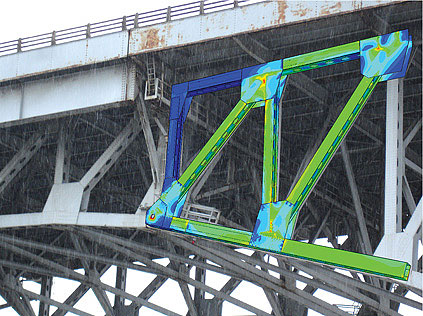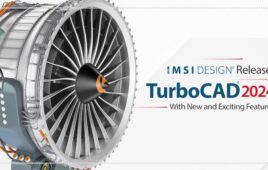Safety concerns have restricted traffic over the main freeway bridge through downtown Cleveland, near the area where Design World magazine is published. Now we are finding out that the crisis was revealed by an FEA analysis of a four-sided steel beam on the Inner Belt Bridge over Interstate 90 in downtown Cleveland. The story was written by reporter Karen Farkas of the Plain Dealer.

Abaqus FEA was used to perform a three dimensional nonlinear stress analysis of the lower chord and gusset plates, shown superimposed on Cleveland’s Inner Belt I-90 Bridge.
Image courtesy of Simulia Erie office.
The image indicated the bridge chord was under extreme stress and could no longer support a full load of traffic on the eight-lane span over I-90. Should the chord fail, the entire bridge might crumble. So the Ohio Dept. of Transportation (ODOT) immediately closed the outer lanes to reduce weight on the bridge. A day later, two more lanes were shut down. Today, an outer lane in each direction remains closed and trucks are banned from using the bridge.
The 3D computer technology convinced the state agency to scrap a plan to spend $240 million to rehab the 50-yr-old bridge. Instead, the bridge will be demolished in 2014 and replaced by a new span.
The Inner Belt bridge likely is the most analyzed bridge in the US, says ODOT. The 3D imaging that detected the chord problem was used to examine the structure’s more than 7000 beams. Bridge data, including calculations from the original plans when the structure was built and measurements of the current steel beams, were entered into a computer. Results were compared to inspections and load and stress tests on the bridge.
This was one of the largest trusses of its type still in existence and in need of a major overhaul. Even though visual inspections and ultrasonic thickness tests had documented the bridge’s condition, no one knew before the analysis that the chord was overstressed.
This simulation was one part of a larger engineering project directed by ODOT involving various engineering companies. The engineering team at Simulia’s Erie office used their Abaqus FEA software to perform a structural analysis of the Inner Belt I-90 Bridge for ODOT. The analysis included geometric and material nonlinearities (the steel properties in Abaqus included elastic and plastic behaviors).
The ability to model nonlinearities and the ease of modeling riveted connections were the most important factors in ODOT’s choice of using Abaqus. The post-processing capabilities of Abaqus-including the ability to create free body cuts and section cuts of the 3D analysis-enabled ODOT engineers to visualize stress profiles, deformed plots and potential buckling modes, which helped them make better informed repair decisions. Overall it was the ability to see the nonlinear stress results in 3D that helped the engineers gain a better understanding of the stresses and deformations occurring in the bridge structure.
Dassault Systèmes SIMULIA
www.simulia.com
Filed Under: Software • FEA, Software • simulation, ENGINEERING SOFTWARE





Tell Us What You Think!